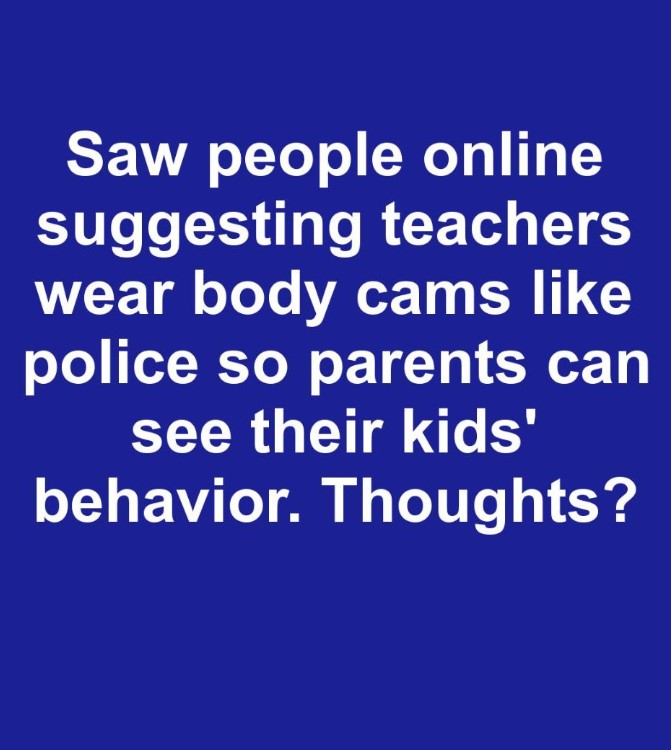In the modern world, technology has become an essential tool in various sectors, and its role in education is no exception. Recently, the widespread use of body cameras in law enforcement has sparked a conversation about their potential use in other areas of society, such as education. This proposal for teachers to wear body cameras in classrooms has generated debate about the implications for transparency, privacy, and accountability in schools.
While the idea of introducing such technology is intriguing, it raises fundamental questions about how we balance the need for transparency with the protection of individual rights and privacy.
The Case for Transparency and Accountability in Education
Advocates for the use of body cameras in schools argue that this technology could significantly enhance transparency and accountability within the educational environment. Much like their application in law enforcement, body cameras could provide an unbiased, clear record of events occurring within the classroom. This could be particularly valuable in addressing disputes between teachers, students, and parents. For example, if a conflict arises over a student’s behavior or a teacher’s actions, the footage from a body camera could offer an objective perspective, helping to resolve misunderstandings or false accusations.
By creating a transparent environment, body cameras could also foster an atmosphere of trust and open communication between schools and families. Parents, who are often concerned about the well-being and development of their children, could have direct access to footage from the classroom. This, in turn, could encourage a more candid discussion about teaching practices, student behavior, and the dynamics within the school.
Empowering Parental Involvement with Technology
One of the most compelling arguments for implementing body cameras in schools is the potential to enhance parental involvement. With access to classroom footage, parents could gain a deeper understanding of their child’s day-to-day experiences, including their behavior, interactions with peers, and engagement with teachers. This insight could serve as a powerful tool for parents to support their children’s education more effectively, particularly when it comes to addressing behavioral concerns or reinforcing positive classroom behaviors.
Parents would no longer have to rely solely on reports from teachers or occasional parent-teacher conferences. Instead, they could directly observe classroom interactions and better understand their child’s academic and social environment. This transparency could encourage a more collaborative relationship between home and school, where both parties work together to ensure the success and well-being of the child.
Body Cameras as a Tool for Teacher Development
Beyond benefiting parents, body cameras could also play a significant role in the professional development of teachers. By reviewing footage of their own teaching methods, educators could identify areas for improvement, refine their classroom management skills, and develop more effective strategies for engaging students. Self-reflection is a critical aspect of professional growth, and body cameras could serve as a valuable tool for teachers to evaluate their instructional approaches and identify strengths and weaknesses.
Furthermore, having access to video footage of classroom activities could help teachers better understand how their students respond to various teaching techniques. This could lead to more personalized and adaptive approaches to education, ultimately enhancing the overall quality of instruction and supporting better learning outcomes for students.
Enhancing Safety and Addressing Misconduct
Another potential advantage of body cameras in schools is the ability to improve safety by discouraging inappropriate behavior. The presence of cameras may act as a deterrent for both students and teachers, encouraging them to maintain professionalism and respect for others. In cases of bullying, misconduct, or other problematic behavior, having a video record could provide clarity and accountability.
For instance, if a bullying incident occurs, the footage from a teacher’s body camera could provide concrete evidence of the event, helping to prevent the situation from escalating or being dismissed. Similarly, if a teacher is accused of inappropriate behavior, the footage could offer a transparent, verifiable record of the interaction, helping to ensure fairness for both the student and the teacher involved.
Privacy and Ethical Considerations: A Delicate Balance
Despite the potential benefits, the use of body cameras in schools raises serious concerns about privacy and ethics. Recording every moment in the classroom could infringe on the privacy rights of both students and teachers. For instance, students may feel uncomfortable knowing they are constantly being recorded, which could affect their behavior and willingness to participate freely in class discussions.
Moreover, there are questions about how the recorded footage would be handled. Would parents be able to access footage of other students, or only their own child? Would there be safeguards in place to prevent the misuse of footage, such as unauthorized sharing or editing of videos for malicious purposes? These concerns underscore the need to carefully consider the ethical implications of implementing body cameras in schools and develop strict policies around the use of the technology.
Data Management and Security Challenges
Implementing body cameras in schools would also introduce significant challenges in data management and security. Schools would need to establish systems for storing and protecting the vast amounts of video footage generated by the cameras. Ensuring that this data is secure and protected from unauthorized access is critical, particularly given the sensitive nature of the information. Any breaches in security could lead to violations of privacy and damage trust between schools and families.
In addition to storage, schools would need to develop protocols for managing the footage. For example, how long should videos be kept? Should they be accessible to all stakeholders, or only authorized personnel? Clear guidelines would be necessary to prevent the mishandling or misuse of footage.
The Risk of Misinterpretation and Misuse
Another potential drawback of body cameras in education is the risk of misinterpretation. Without proper context, video footage can be easily misunderstood. For instance, a brief moment captured on video could be taken out of context, leading to false assumptions about the behavior or intentions of a teacher or student. Inaccurate interpretations of classroom events could lead to unjust consequences, which highlights the importance of providing context and oversight when reviewing body camera footage.
Additionally, there is a concern that footage could be selectively edited or manipulated to serve specific agendas. This could undermine the integrity of the educational process and lead to misunderstandings or unfair treatment of teachers and students.
Financial Considerations: The Cost of Implementation
Implementing body cameras in schools would require a significant financial investment. Schools would need to purchase the cameras, set up data storage infrastructure, and ensure proper training for staff members. The cost of maintaining the system and securing the data could also be substantial. As such, school districts would need to carefully evaluate whether the benefits of body cameras justify the investment.
Moreover, funds allocated to body cameras could divert resources away from other important educational priorities, such as curriculum development, teacher training, or student support services. Therefore, it is essential for schools to weigh the costs against the potential benefits before moving forward with such an initiative.
The Importance of Stakeholder Involvement
Given the complexity of the issue, it is essential to engage all stakeholders—teachers, students, parents, and administrators—in the decision-making process. Open dialogue and consultations would help to address concerns and ensure that the decision to implement body cameras is made with input from those directly affected. Informed, collaborative discussions will help create a balanced approach that considers the needs and perspectives of the entire educational community.
Conclusion:
A Step Toward a Transparent Future?
In conclusion, while the idea of introducing body cameras in classrooms presents intriguing possibilities for increasing transparency, accountability, and parental involvement, it also raises significant concerns about privacy, ethics, and the potential for misuse. The decision to implement such technology in schools should be approached with caution, weighing both the potential benefits and the risks. Engaging all stakeholders in thoughtful, open discussions is key to ensuring that any decision made is in the best interests of students, teachers, and the broader educational community.
Ultimately, body cameras may serve as one tool among many in the quest for a more transparent, accountable educational system—but their implementation must be carefully considered to strike a balance between openness and privacy.










